 What a relief that this last container load of garden ornament from England is finally in my possession. Though importing garden ornament from Europe really belongs on that “do not try this at home” list, it is incredibly exciting to cut off that lock, and unload the truck. It has been seven months since Rob shopped in England-for him, the unloading is old home week. I am always surprised by what I see, in spite of the fact that he sends me lots of pictures. There is no substitute for the real thing.
What a relief that this last container load of garden ornament from England is finally in my possession. Though importing garden ornament from Europe really belongs on that “do not try this at home” list, it is incredibly exciting to cut off that lock, and unload the truck. It has been seven months since Rob shopped in England-for him, the unloading is old home week. I am always surprised by what I see, in spite of the fact that he sends me lots of pictures. There is no substitute for the real thing.
 Some purchases might make you wonder. Who imports fence poles from England? Someone whose romance with the garden is long standing and on going-that would be Rob. These are no ordinary fence poles. They are whittled from sweet chestnut with a draw knife, and designed to anchor rolls of sweet chestnut pale fencing. Castanea sativa was introduced to Britain by the Romans; it is a very important tree in the English landscape. An introduction to a segment of British gardening life is what came off the container-not a pallet of poles.
Some purchases might make you wonder. Who imports fence poles from England? Someone whose romance with the garden is long standing and on going-that would be Rob. These are no ordinary fence poles. They are whittled from sweet chestnut with a draw knife, and designed to anchor rolls of sweet chestnut pale fencing. Castanea sativa was introduced to Britain by the Romans; it is a very important tree in the English landscape. An introduction to a segment of British gardening life is what came off the container-not a pallet of poles.
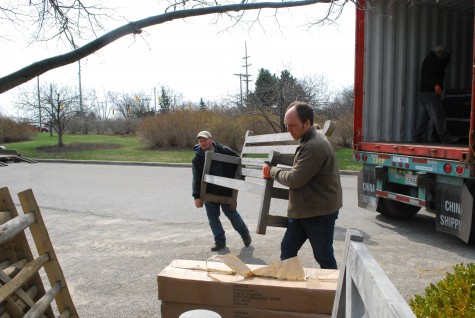 An exposure to the tools and ornament of a garden culture other than my own is a gift from an unlikely source-modern technology. I am sure there was a time when garden ornament never travelled far from where it was made. The ocean between my garden, and a British garden, does not seem as large as it once was, given shipping containers, giant boats, and trucks-not to mention the communications systems that keep them all functioning towards a specific end. My local decomposed granite is so different than that granite available in California, but should you want our granite, it is possible for you to have it.
An exposure to the tools and ornament of a garden culture other than my own is a gift from an unlikely source-modern technology. I am sure there was a time when garden ornament never travelled far from where it was made. The ocean between my garden, and a British garden, does not seem as large as it once was, given shipping containers, giant boats, and trucks-not to mention the communications systems that keep them all functioning towards a specific end. My local decomposed granite is so different than that granite available in California, but should you want our granite, it is possible for you to have it.
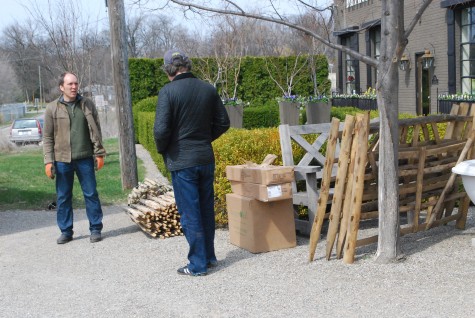 These large simple wood panels are known as sheep’s hurdles. They are traditionally used to make a temporary pen for sheep taken to market. What would I do with them? One panel would make a suberb support for a lax growing rose; a pair might beautifully signal the entrance to a vegetable or cutting garden. They would make a great companion to any number of vining plants.
These large simple wood panels are known as sheep’s hurdles. They are traditionally used to make a temporary pen for sheep taken to market. What would I do with them? One panel would make a suberb support for a lax growing rose; a pair might beautifully signal the entrance to a vegetable or cutting garden. They would make a great companion to any number of vining plants.
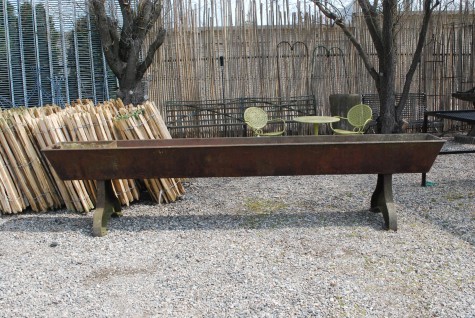 A pair of Victoian era cast iron horse troughs took my breath away. OK, how does a horse trough get this level of respect? They are visually very strong, and have great scale.
A pair of Victoian era cast iron horse troughs took my breath away. OK, how does a horse trough get this level of respect? They are visually very strong, and have great scale.
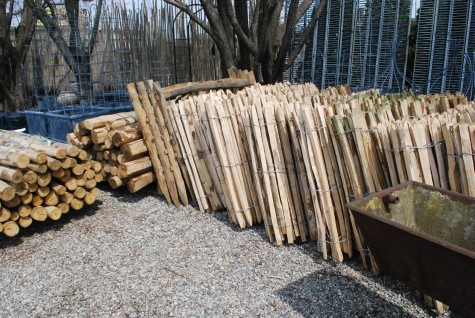 Six inch diameter chestnut poles are processed for fencing on a woodland site by a pale-maker. The poles are stripped of their bark, and then they are riven by hand on the radial axis, to produce those fairly regular triangular shaped slats know as pales. Once bound together with galvanized wire, the result is a rustic but entirely serviceable fencing. The Chestnut Fencing Manufacturer’s Society puts the lifespan of this fencing at 20 years or better. All of the above is courtesy of Chris Howkins’ book “Sweet Chestnut: History, Landscape, People”.
Six inch diameter chestnut poles are processed for fencing on a woodland site by a pale-maker. The poles are stripped of their bark, and then they are riven by hand on the radial axis, to produce those fairly regular triangular shaped slats know as pales. Once bound together with galvanized wire, the result is a rustic but entirely serviceable fencing. The Chestnut Fencing Manufacturer’s Society puts the lifespan of this fencing at 20 years or better. All of the above is courtesy of Chris Howkins’ book “Sweet Chestnut: History, Landscape, People”.
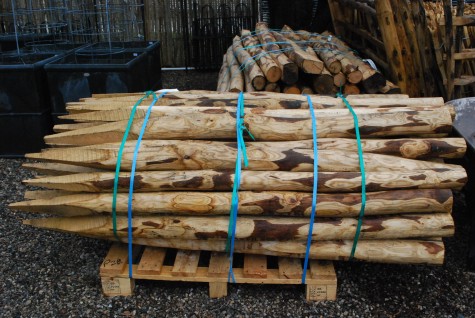 These poles will do an admirable job of holding up the paling fencing. Their history will add a good deal of flavor to a garden.
These poles will do an admirable job of holding up the paling fencing. Their history will add a good deal of flavor to a garden.
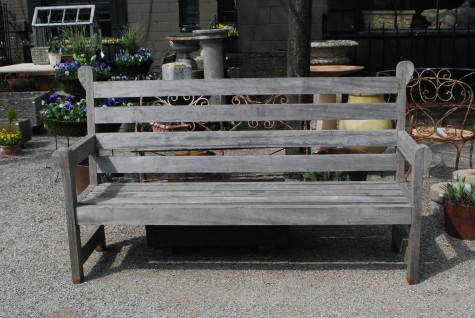 This weathered English bench is of classical design and workmanship. Made from both teak and iroko, it has many years of service ahead of it.
This weathered English bench is of classical design and workmanship. Made from both teak and iroko, it has many years of service ahead of it.
 And for the first time, Burgon and Ball garden tools. Based in Sheffield, England, they make sheep shears-perfect for pruning the soft growth on boxwood.
And for the first time, Burgon and Ball garden tools. Based in Sheffield, England, they make sheep shears-perfect for pruning the soft growth on boxwood.
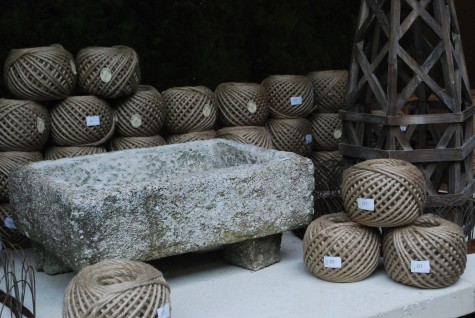 And lest I forget-this container had boxes and boxes of Nutscene jute garden twine. Just to open the boxes is an experience; that organic and pungent smell of jute filled the garage. We have just about all the fixings for a great spring now. Like every other gardener we are impatiently waiting on some spring weather to go with.
And lest I forget-this container had boxes and boxes of Nutscene jute garden twine. Just to open the boxes is an experience; that organic and pungent smell of jute filled the garage. We have just about all the fixings for a great spring now. Like every other gardener we are impatiently waiting on some spring weather to go with.
